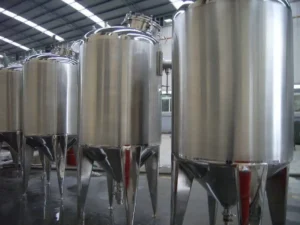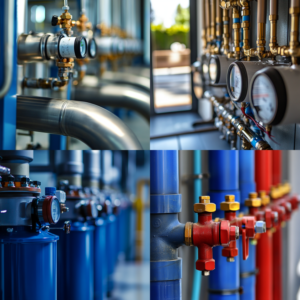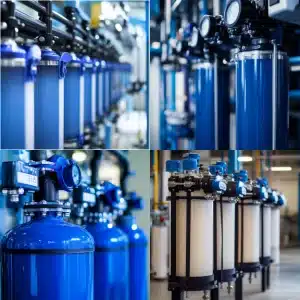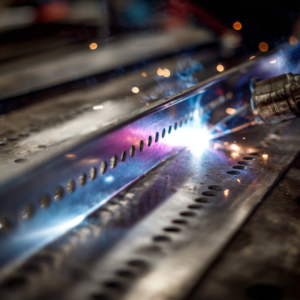
What is pulsation vessel?
A pulsation vessel, also called a pulsation bottle, is a key part of many industrial systems. Its main job is to manage and reduce pressure fluctuations. These vessels are built into pipelines or equipment to absorb shocks and pulsations from pumps, compressors, or other dynamic devices.
By buffering against sudden pressure changes, pulsation vessels help stabilize the system. They also protect downstream equipment from damage.
Importance in industrial settings:
In industrial systems, controlling fluid flow and pressure is critical. Pulsation vessels play a vital role in keeping pipelines and pumps running smoothly. They reduce vibrations, pulsations, and pressure spikes that could cause wear or damage.
Without them, systems can become inefficient and prone to failures. That’s why proper design, installation, and maintenance are crucial. These vessels help optimize performance, improve safety, and extend the life of industrial equipment.
Purpose of the outline:
This outline gives a complete overview of pulsation vessels and bottles. It includes their definition, function, types, applications, benefits, selection criteria, and installation tips. You’ll also learn about maintenance, troubleshooting, and future trends.
By breaking down each topic, this guide helps readers better understand the role of pulsation vessels. It also acts as a roadmap for exploring each section in detail—making it easier to grasp this important component of fluid systems.
Basics of Pulsation Vessels
Definition and Function:
Pulsation vessels, also referred to as pulsation bottles, are specially designed containers integrated into industrial fluid systems to mitigate pressure fluctuations. Their primary function is to absorb and dampen pulsations, surges, and vibrations generated by dynamic equipment such as pumps, compressors, or reciprocating engines. By acting as a buffer, pulsation vessels help maintain a more constant flow and pressure within the system, ensuring smoother operation and reducing stress on downstream components.
Components and Construction:
Pulsation vessels typically consist of a cylindrical or spherical shell made from materials capable of withstanding high pressures and corrosive environments commonly found in industrial applications. The vessel may include additional components such as inlet and outlet connections, pressure relief valves, gauges, and mounting brackets. Internal configurations may vary depending on the specific design and application requirements, but often include baffles, diaphragms, or bladder systems to enhance performance and efficiency.
Working Principle:
The working principle of pulsation vessels revolves around the concept of volume elasticity and compressibility. When fluid flow experiences sudden changes in velocity or direction, it creates pressure fluctuations within the system. Pulsation vessels exploit the elasticity of trapped air or other compressible mediums inside the vessel to absorb these pressure variations. As the fluid pressure increases, the compressible medium compresses, storing potential energy. Conversely, when pressure decreases, the compressed medium expands, releasing stored energy to maintain system pressure within acceptable limits. This cyclical process helps dampen pulsations and fluctuations, promoting smoother fluid flow and reducing the risk of damage to system components.
Applications of Pulsation Vessels
Oil and Gas Industry:
Pulsation vessels find extensive use in the oil and gas sector, where they are deployed in various applications such as drilling, production, refining, and transportation. In drilling operations, pulsation vessels help mitigate pressure fluctuations generated by mud pumps, enhancing drilling efficiency and protecting downhole equipment. In production and refining processes, they play a crucial role in managing flow dynamics, reducing vibration-induced wear on pipelines and equipment, and ensuring the integrity of critical components.
Chemical Processing Plants:
Chemical processing plants rely on pulsation vessels to maintain stable pressure and flow conditions in complex piping networks used for mixing, blending, reaction, and separation processes. These vessels help minimize the impact of pressure surges and pulsations caused by pumps, valves, and other equipment, thereby improving process efficiency, product quality, and safety. Additionally, in applications involving corrosive or hazardous fluids, pulsation vessels aid in protecting equipment from damage and extending service life.
Water Treatment Facilities:
Pulsation vessels play a vital role in water treatment facilities, where they help regulate pressure fluctuations in pumping systems used for filtration, disinfection, and distribution of potable water. By dampening pressure surges and pulsations, these vessels contribute to the stability and reliability of water treatment processes, minimizing the risk of pipeline bursts, equipment failure, and service disruptions. Furthermore, pulsation vessels enhance the performance of water treatment systems by ensuring consistent flow rates and reducing energy consumption.
Other Industrial Sectors:
Beyond the aforementioned industries, pulsation vessels find applications in a wide range of industrial sectors, including power generation, mining, food and beverage processing, pharmaceutical manufacturing, and pulp and paper production. In power generation plants, for instance, pulsation vessels are employed to stabilize pressure fluctuations in steam, gas, or hydraulic systems, optimizing turbine performance and minimizing stress on associated components. Similarly, in food processing facilities, pulsation vessels help maintain precise pressure control in conveying, mixing, and packaging operations, ensuring product quality and safety. Overall, the versatility and effectiveness of pulsation vessels make them indispensable components across diverse industrial applications.
Benefits of Pulsation Vessels
Reduction of Pulsations and Vibrations:
Pulsation vessels play a crucial role in reducing pulsations and vibrations within industrial fluid systems. By absorbing and dampening pressure fluctuations caused by dynamic equipment such as pumps, compressors, and reciprocating engines, these vessels help maintain a smoother and more consistent flow of fluids. This reduction in pulsations and vibrations not only enhances the stability and performance of the system but also minimizes the risk of damage to sensitive components, such as valves, seals, and instrumentation.
Reduction of Pulsations and Vibrations:
Pulsation vessels play a crucial role in reducing pulsations and vibrations within industrial fluid systems. By absorbing and dampening pressure fluctuations caused by dynamic equipment such as pumps, compressors, and reciprocating engines, these vessels help maintain a smoother and more consistent flow of fluids. This reduction in pulsations and vibrations not only enhances the stability and performance of the system but also minimizes the risk of damage to sensitive components, such as valves, seals, and instrumentation.
Protection of Equipment:
One of the primary benefits of pulsation vessels is their ability to protect downstream equipment from the adverse effects of pressure surges and shockwaves. By serving as a buffer against sudden changes in pressure, pulsation vessels prevent excessive stress and fatigue on pipes, fittings, pumps, and other system components. This protection is particularly critical in industrial settings where equipment reliability and uptime are paramount, as it helps prevent premature failures, costly repairs, and unplanned downtime.
Improvement of System Efficiency:
Pulsation vessels contribute to the overall efficiency of industrial fluid systems by optimizing pressure control and flow dynamics. By stabilizing pressure fluctuations, these vessels promote more uniform flow rates and minimize energy losses associated with turbulent flow. This improvement in system efficiency translates into reduced energy consumption, lower operating costs, and enhanced productivity. Additionally, by mitigating the effects of pressure pulsations on equipment performance, pulsation vessels help maintain consistent process conditions, further enhancing system efficiency and product quality.
Extension of Equipment Lifespan:
Another significant benefit of pulsation vessels is their role in extending the lifespan of equipment and infrastructure within industrial fluid systems. By reducing the incidence of pressure spikes and cyclic loading on mechanical components, pulsation vessels help mitigate fatigue and corrosion, which are common causes of equipment degradation and failure. This extension of equipment lifespan not only reduces maintenance requirements and downtime but also enhances the overall reliability and safety of industrial operations. As a result, investments in pulsation vessels yield long-term benefits by prolonging the service life of critical assets and infrastructure.
Types of Pulsation Vessels
Bladder-type Pulsation Vessels:
Bladder-type pulsation vessels feature a flexible bladder or membrane housed within a pressure vessel. The bladder separates the fluid from a compressed gas (typically nitrogen) charge, allowing for the expansion and contraction of the gas as fluid pressure changes. This design ensures that the fluid remains isolated from the gas, preventing contamination and maintaining system integrity. Bladder-type pulsation vessels are known for their compact size, high efficiency, and versatility, making them suitable for a wide range of industrial applications.
Diaphragm-type Pulsation Vessels:
Diaphragm-type pulsation vessels employ a flexible diaphragm to separate the fluid from a compressible gas charge. As fluid pressure fluctuates, the diaphragm flexes inward or outward, accommodating changes in volume within the vessel. This design provides effective pulsation dampening while minimizing the risk of fluid leakage or contamination. Diaphragm-type pulsation vessels are valued for their reliability, durability, and ease of maintenance, making them popular choices for critical industrial processes where fluid purity and system integrity are paramount.
Piston-type Pulsation Vessels:
Piston-type pulsation vessels utilize a movable piston or plunger to separate the fluid from a gas or liquid charge. As fluid pressure fluctuates, the piston moves within the vessel, compressing or expanding the gas or liquid charge to accommodate changes in volume. This design offers precise control over pressure regulation and pulsation damping, making piston-type pulsation vessels well-suited for applications requiring high-pressure stability and dynamic response. However, piston-type vessels may be more complex and costly to manufacture and maintain compared to bladder or diaphragm-type vessels, limiting their suitability for certain industrial applications.
Considerations for Selecting Pulsation Vessels
Pressure and Temperature Requirements:
When selecting pulsation vessels, it’s crucial to consider the specific pressure and temperature conditions within the industrial system. Pulsation vessels must be designed to withstand the maximum operating pressure and temperature encountered during normal operation. Additionally, factors such as pressure fluctuations, shock loads, and thermal cycling should be taken into account to ensure the vessel’s structural integrity and performance under varying conditions.
Size and Capacity:
The size and capacity of pulsation vessels play a critical role in determining their effectiveness in mitigating pressure fluctuations within the system. The vessel’s volume should be sufficient to accommodate the expected flow rates and pulsation frequencies while maintaining adequate pressure control. Oversized vessels may lead to inefficiencies and unnecessary costs, while undersized vessels may fail to provide adequate pulsation dampening. Proper sizing requires careful analysis of system dynamics, including flow rates, pressure profiles, and operating conditions.
Material Compatibility:
Pulsation vessels must be constructed from materials that are compatible with the fluid composition and environmental conditions of the industrial system. The selected materials should possess corrosion resistance, mechanical strength, and thermal stability to ensure long-term reliability and performance. Factors such as fluid type, pH, temperature, and presence of corrosive agents should be considered when choosing vessel materials. Common materials used for pulsation vessels include stainless steel, carbon steel, fiberglass-reinforced plastic (FRP), and unfamiliar alloys.
Installation and Maintenance Considerations:
Proper installation and maintenance are essential for maximizing the effectiveness and longevity of pulsation vessels. During installation, attention should be paid to factors such as mounting orientation, support structures, piping connections, and accessibility for inspection and servicing. Routine maintenance activities may include inspection of vessel integrity, pressure testing, cleaning, and replacement of internal components as needed. Additionally, consideration should be given to factors such as safety protocols, regulatory compliance, and industry standards when installing and maintaining pulsation vessels. By adhering to best practices in installation and maintenance, users can ensure optimal performance and reliability of pulsation vessels throughout their service life.
Installation and Maintenance of Pulsation Vessels
Proper Positioning and Mounting:
- Ensure proper alignment: Pulsation vessels should be installed in a location where they can effectively absorb pressure fluctuations and vibrations. Proper alignment with the fluid flow path is essential for optimal performance.
- Mount securely: Securely mount the pulsation vessel to a stable structure using appropriate brackets or supports. Ensure that the mounting hardware is compatible with the vessel’s size, weight, and operating conditions to prevent displacement or damage during operation.
Regular Inspection and Monitoring:
- Visual inspection: Conduct periodic visual inspections of the pulsation vessel to check for signs of damage, corrosion, or leakage. Pay attention to welds, fittings, and pressure relief devices.
- Pressure monitoring: Monitor pressure levels within the system to ensure that they remain within the recommended operating range. Use pressure gauges or sensors to track pressure fluctuations and identify potential issues.
- Vibration analysis: Monitor vibration levels in the vicinity of the pulsation vessel to detect abnormal oscillations that may indicate mechanical problems or misalignment.
Maintenance Schedules and Procedures:
- Regular maintenance: Create a routine schedule. Include cleaning, lubrication, and critical component inspections. Follow the manufacturer’s guidelines and industry best practices.
- Check seals and gaskets: Inspect seals, gaskets, and O-rings for wear. Replace damaged or worn parts to prevent leaks and maintain system performance.
- Test pressure relief devices: Test valves and relief devices often. Make sure they work properly and meet safety regulations. Adjust the settings if needed.
- Clean internal surfaces: Flush and clean the vessel’s interior to remove debris, sediment, or corrosion. Use proper cleaning agents and methods to maintain performance.
- Document maintenance activities: Keep clear records of inspections, repairs, and replacements. This supports performance tracking, troubleshooting, and regulatory compliance.
Common Issues and Troubleshooting
Leakage
Leakage from pulsation vessels can occur due to various reasons such as damaged seals, gaskets, or welds, excessive pressure, or corrosion. To troubleshoot leakage issues, inspect the vessel’s connections, seals, and welds for signs of damage or deterioration. Tighten loose fittings, replace damaged seals or gaskets, and repair any leaks promptly to prevent further fluid loss and maintain system integrity. Additionally, ensure that the vessel is operating within its specified pressure and temperature limits to minimize the risk of leakage.
Corrosion:
Corrosion can compromise the integrity of pulsation vessels, leading to structural weakening and potential failure. To address corrosion issues, regularly inspect the vessel’s internal and external surfaces for signs of corrosion, such as rust, pitting, or discoloration. Implement corrosion prevention measures, such as applying protective coatings, using corrosion-resistant materials, or installing sacrificial anodes. Additionally, monitor fluid chemistry and pH levels to prevent corrosive conditions and ensure proper maintenance practices, such as cleaning and flushing, to remove corrosion-causing contaminants.
Pressure Fluctuations:
Pressure fluctuations within pulsation vessels can result from improper sizing, inadequate system design, or fluctuations in upstream flow conditions. To troubleshoot pressure fluctuation issues, verify that the vessel is correctly sized and configured to handle the anticipated flow rates and pressure variations. Check for obstructions or blockages in the inlet or outlet lines that may affect fluid flow and pressure regulation. Adjust system settings, such as pump speed or valve positions, to maintain stable pressure conditions within the vessel. Consider installing additional pressure relief devices or control valves to mitigate sudden pressure spikes and fluctuations.
Noise and Vibration:
Excessive noise and vibration from pulsation vessels can indicate mechanical problems, such as unbalanced loads, loose components, or resonance issues. To troubleshoot noise and vibration problems, inspect the vessel and associated equipment for signs of mechanical wear or damage, including loose fasteners, misaligned shafts, or worn bearings. Balance rotating components, tighten loose connections, and align shafts to minimize vibration levels. Install vibration dampeners or isolation mounts to reduce noise transmission and dampen vibration resonance. Additionally, consider conducting vibration analysis and modal testing to identify and address underlying structural or dynamic issues contributing to noise and vibration problems.
Need a reliable partner?
Red River specializes in the design and manufacturing of pressure vessels. We also fabricate related items such as prefabricated spools and skid packages.
Reach Out to us today and experience the Red River difference. Where American Made and American Values come together, we care more.
FAQ’s
How do you select the right size of a pulsation vessel for a system?
Selecting the right size of a pulsation vessel involves calculating the volume of fluid that needs to be dampened, the operating pressure of the system, and the desired pulsation reduction level. Factors like the pump or compressor flow rate, stroke volume, and system fluid dynamics are also crucial. Manufacturers often provide selection guidelines or software to assist in choosing the appropriate size.
How can you tell if a pulsation vessel is not functioning properly?
Signs of a malfunctioning pulsation vessel include increased vibration or noise in the system, fluctuating pressure readings beyond normal levels, visible damage or leakage, and a decrease in system performance or efficiency. Regular monitoring and maintenance are key to identifying and addressing any issues promptly.
Are there any regulations or standards that apply to pulsation vessels?
Yes, pulsation vessels are subject to various industry standards and regulations that dictate their design, construction, and testing. Common standards include those from the American Society of Mechanical Engineers (ASME), European Pressure Equipment Directive (PED), and others specific to industries or regions. Compliance ensures safety, reliability, and performance.
What are the main advantages of using pulsation vessels in fluid systems?
The main advantages include improved operational stability, reduced mechanical stress and wear on system components, lowered noise levels, enhanced efficiency, and increased safety. Pulsation vessels help in achieving a smoother flow, which is beneficial for both the process quality and equipment longevity.
Are there any new developments or innovations in pulsation vessel technology?
Innovations in materials technology, such as the use of advanced polymers and composites, are improving the durability and performance of pulsation vessels. Developments in smart monitoring systems, which can predict maintenance needs and optimize performance, are also becoming more common. Additionally, there’s a focus on designing more environmentally friendly and energy-efficient solutions to meet the demands of modern industries.
Related Blog Post

How a Glycol System Works

Ethylene Glycol Water: A Complete Heat Transfer Guide

Water Filter Replacement

Why Use Stainless Steel Sheet Metal Fabrication?

How Does Stainless Steel Sheet Metal Fabrication Work
About Author

